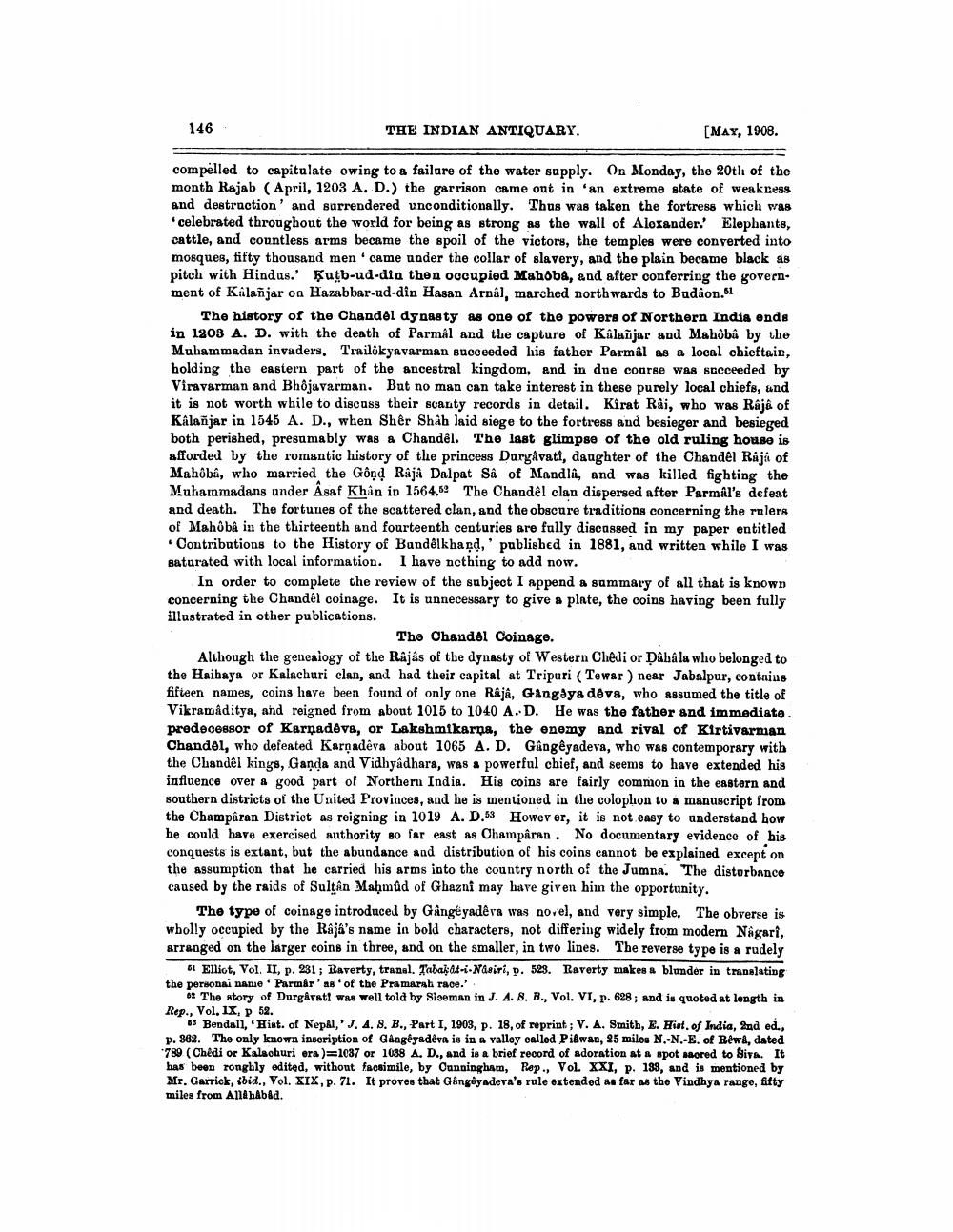________________
146
THE INDIAN ANTIQUARY.
[MAY, 1908.
compelled to capitulate owing to failare of the water supply. On Monday, the 20th of the month Rajab (April, 1203 A. D.) the garrison came out in an extreme state of weakness and destruction' and surrendered unconditionally. Thus was taken the fortress which was ' celebrated throughout the world for being as strong as the wall of Aloxander.' Elephants, cattle, and countless arms became the spoil of the victors, the temples were converted into mosques, fifty thousand men came under the collar of slavery, and the plain became black as pitch with Hindus.' Kutb-ud-din then occupied Mahoba, and after conferring the government of Kilañjar on Hazabbar-ud-din Hasan Arnál, marched northwards to Budkon.si
The history of the Chandel dynasty as one of the powers of Northern India ende in 1203 A. D. with the death of Parmál and the capture of Kalañjar and Mahobâ by the Muhammadan invaders, Trailokyavarman succeeded his father Parmál as a local chieftain, holding the eastern part of the ancestral kingdom, and in due course was succeeded by Viravarman and Bhôjavarman. But no man can take interest in these purely local chiefs, and it is not worth while to discuss their scanty records in detail. Kirat Rai, who was Raja of Kalañjar in 1545 A. D., when Sher Shah laid siege to the fortress and besieger and besieged both perished, presumably was a Chandel. The last glimpse of the old ruling house is afforded by the romantic history of the princess Dargavati, daughter of the Chandel Râjá of Mahoba, who married the Gônd Raja Dalpat Så of Mandla, and was killed fighting the Muhammadans under Asaf Khan in 1564.69 The Chandel clan dispersed after Parmal's defeat and death. The fortunes of the scattered clan, and the obscure traditions concerning the rulers of Mahobâ in the thirteenth and fourteenth centuries are fully discassed in my paper entitled • Contributions to the History of Bandôlkhagd, published in 1881, and written while I was saturated with local information. I have nothing to add now.
In order to complete the review of the subject I append a summary of all that is known concerning the Chandel coinage. It is unnecessary to give a plate, the coins having been fully illustrated in other publications.
The Chandel Coinage. Although the genealogy of the Rajás of the dynasty of Western Chêdi or Dâhâ la who belonged to the Haibaya or Kalachuri clan, and had their capital at Tripari (Tewar ) near Jabalpur, contains fifteen names, coins have been found of only one Raja, Gangaya deva, who assumed the title of Vikramaditya, and reigned from about 1015 to 1040 A.D. He was the father and immediate. predecessor of Karnadeve, or Lakshmikarna, the enemy and rival of Kirtivarman Chandel, who defeated Karnadeva about 1065 A. D. Gângêyadeva, who was contemporary with the Chandel kings, Ganda and Vidhyadhara, was a powerful chief, and seems to have extended his influence over a good part of Northern India. His coins are fairly common in the eastern and southern districts of the United Provinces, and he is mentioned in the colophon to a manuscript from the Champaran District as reigning in 1019 A. D.53 However, it is not easy to understand how he could have exercised authority so far east as Champaran. No documentary evidence of his conquests is extant, but the abundance and distribution of his coins cannot be explained except on the assumption that he carried his arms into the country north of the Jumna. "The disturbance caused by the raids of Sultan Mahmud of Ghazni may have given him the opportunity.
The type of coinage introduced by Gangéyadêra was novel, and very simple. The obverse is wholly occupied by the Raja's name in bold characters, not differing widely from modern Nagari, arranged on the larger coins in three, and on the smaller, in two lines. The reverse type is a rudely
Elliot, Vol. II, p. 231; Raverty, transl. Tabakat-i-Nasiri, p. 523. Raverty makes a blunder in translating the personai nanie. Parmar' as of the Pramarak race.'
02 The story of Durgavatt was well told by Siseman in J. A. 8. B., Vol. VI, p. 628 ; and is quoted at length in Rep., Vol. IX, p 52.
o Bendall, Hist. of Nepal, J. 4. 8. B., Part I, 1903, p. 18, of reprint ; V. A. Smith, E. Hist. of India, 2nd ed., p. 362. The only known inscription of Gangéyadeva is in a valley called Pilwan, 25 miles N.-N.-E. of Rewa, dated *789 (Chedi or Kalachuri era )=1037 or 1088 A. D., and is a brief record of adoration at a spot sacred to Siya. It has been ronghly edited, without faosimile, by Cunningham, Rep., Vol. XXI, p. 188, and is mentioned by Mr. Garrick, bid., Vol. XIX, p. 71. It proves that Gångøyadeva's rule extended as far as the Vindhya range, fifty miles from Anå håbed.




